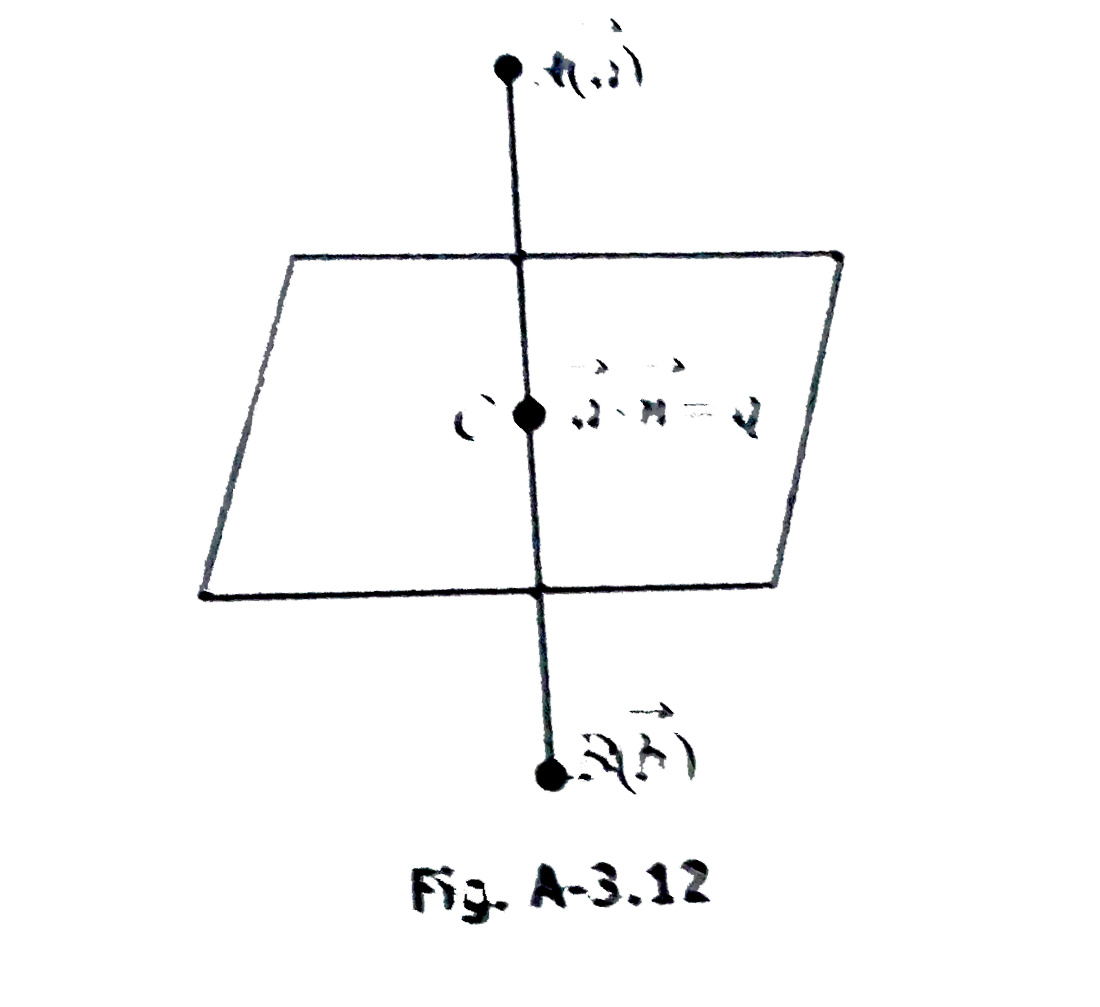The reflection of the point →a in the plane →r.→n=q is (A) →a+→q−→a.→n|→n| (B) →a+2(→q−→a.→n|→n|2)→n (C) →a+2(→q+→a.→n)|→n| (D) none of these
→a+(→q−→a.→n)|→n|
→a+2((→q−→a.→n)|→n|2)→n
→a+2(→q−→a.→n)|→n|→n
none of these
The correct Answer is:b
Given plane is →r.→n=q
Let the image of A(→a) in the plane be B(→b).

Equation of AC is →r=→a+λ→n
(∵ AC is normal to the plane) (ii)
Solving (i) and (ii), we get
(→a+λ→n).→n=q
or λ=q−→a.→n|→n|2.→n
But −−→OC=→a+→b2
∵→a+(q−→a.→n)→n|→n|2=→a+→b2
or →b=→a+2(q−→a.→n|→n|2)
Topper's Solved these Questions
- THREE-DIMENSIONAL GEOMETRY BOOK - CENGAGECHAPTER - THREE-DIMENSIONAL GEOMETRY EXERCISE - Exercise (Multiple)
17 Videos
- THREE-DIMENSIONAL GEOMETRY BOOK - CENGAGECHAPTER - THREE-DIMENSIONAL GEOMETRY EXERCISE - Exercise (Reasoning Questions)
10 Videos
- THREE-DIMENSIONAL GEOMETRY BOOK - CENGAGECHAPTER - THREE-DIMENSIONAL GEOMETRY EXERCISE - Exercise (Subjective)
16 Videos
- THREE DIMENSIONAL GEOMETRYBOOK - CENGAGECHAPTER - THREE DIMENSIONAL GEOMETRYEXERCISE - Question Bank
20 Videos
- TRIGNOMETRIC RATIOS IDENTITIES AND TRIGNOMETRIC EQUATIONSBOOK - CENGAGECHAPTER - TRIGNOMETRIC RATIOS IDENTITIES AND TRIGNOMETRIC EQUATIONSEXERCISE - Question Bank
34 Videos
Similar Questions
A straighat line →r=→a+λ→b meets the plane →r.→n=p in the point whose position vector is (A) →a+(→a.ˆn→b.ˆn)→b (B) →a+(p−→a.ˆn→b.ˆn)→b (C) →a−(→a.ˆn→b.ˆn)→b (D) none of these
View SolutionThe distance of the point A(→a) from the line →r=→b+t→c is (A) ∣∣(→a−→b)×→c∣∣ (B) ∣∣(→a−→b)×→c∣∣∣∣(→a−→b)∣∣ (C) ∣∣(→a−→b)×→c∣∣|→c| (D) ∣∣→a×(→b−→c)∣∣|→a|
View Solution
Knowledge Check
The projection of point P(→p) on the plane →r.→n=q is (→s), then
A→s=(q−→p.→n)→n|→n|2B→s=→p+(q−→p.→n)→n|→n|2C→s=→p−(→p.→n)→n|→n|2D→s=→p−(q−→p.→n)→n|→n|2Distance of point P(→P) from the plane →r.→n=0 is
A|→p.→n|B|→p×→n||→n|C|→p.→n||→n|Dnone of theseFind the equation of a straight line in the plane →r.→n=d which is parallel to →r.→n=d(where →n.→b=0).
A→r=→a+(d−→a.→nn2)→n+λ→bB→r=→a+(d−→a.→nn)→n+λ→bC→r=→a+(→a.→n−dn2)→n+λ→bD→r=→a+(→a.→n−dn)→n+λ→b
The equation of the line of intersetion of the planes →r.→n=q,→r.→n'=q' and pasing through the point →a is (A) →r=→a+λ(→n−→n') (B) →r=→a+λ(→n×→n') (C) →r=→a+λ(→n+→n') (D) none of these
View SolutionThe equation of the line throgh the point →a parallel to the plane →r.→n=qand perpendicular to the line →r=→b+t→c is (A) →r=→a+λ(→n×→c) (B) (→r−→a)×(→n×→c)=0 (C) →r=→b+λ(→n×→c) (D) none of these
View SolutionIf →a.→b=βand→a×→b=→c,then→b is (A) β→a−→a×→c|→a|2 (B) β→a+→a×→c|→a|2 (C) β→c−→a×→c|→a|2 (D) β→c+→a×→c|→a|2
View SolutionFor two vectors →aand→b,→a,→b=|→a|∣∣→b∣∣ then (A) →a∣∣→b (B) →a⊥→b (C) →a=→b (D) none of these
View SolutionIf →a,→band→c are three mutually perpendicular unit vectors then (→r.→a)→a+(→r.→b)→b+(→r.→c)→c= (A) [→a→b→c]→r2 (B) →r (C) 2[→a→b→c] (D) none of these
View Solution
